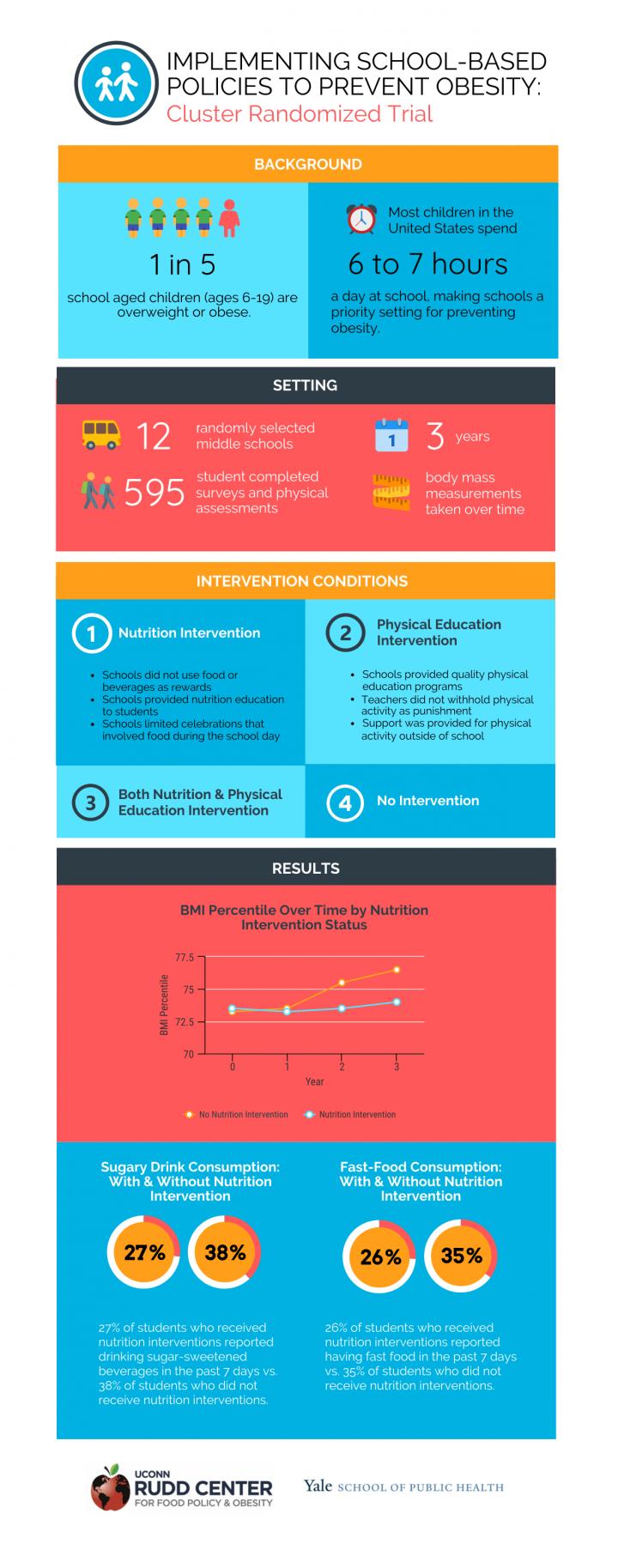
Credit: Kristin Messina, UConn Rudd Center
Hartford, CT – Implementing strong school nutrition policies is associated with healthier weight trajectories in middle school students, according to a new study by researchers at the Rudd Center for Food Policy and Obesity at the University of Connecticut and the Yale School of Public Health.
Study authors randomly selected twelve schools in an urban district, where they followed 595 middle school students for three years, from fifth to eighth grade. Schools were assigned to one of four conditions, which included support for: (1) nutrition policies; (2) physical activity policies; (3) both types of policies; or (4) neither as a delayed control condition.
The nutrition policy interventions included ensuring that all school-based meals met federal nutritional criteria; providing nutritional newsletters for students and their families; school-wide campaigns to limit sugary drinks and encourage the use of water; and limiting the use of food or beverages as rewards for academic performance or good behavior.
Through in-school observations, surveys of student dietary and physical activity behavior, and annual measurement of body mass index by trained staff, the study found that students from the 6 schools randomized to receive nutrition interventions experienced less than a 1% increase in body mass index (BMI) over three years. Students from the 6 schools that did not receive nutrition policy support exhibited a significantly greater BMI increase of 3-4% during the same period.
“This is some of the strongest evidence we have to date that nutrition education and promoting healthy eating behaviors in the classroom and cafeteria can have a meaningful impact on children’s health,” says Marlene Schwartz, Rudd Center Director and senior study author. “These findings can inform how we approach federal wellness policy requirements and implementation in schools to help mitigate childhood obesity.”
Most children in the United States spend an average of 6 to 7 hours a day at school, which is why schools have become a priority setting for preventing childhood obesity. Since 2006, school wellness policies have been required to set goals for physical and nutrition education and to set nutrition standards for meals and snacks served. These requirements were strengthened in 2010 with the Healthy Hunger-Free Kids Act, and while nearly every school district in the country has a written policy to comply with these standards, previous studies have found that strong written policies do not necessarily predict thorough implementation.
This research, published in the American Journal of Preventive Medicine, aimed to assess whether implementation of nutrition and physical activity components of the school wellness policies lead to healthier student outcomes, including BMI trajectories.
Additional key findings of the study include:
- Students in the nutrition policy intervention schools reported lower consumption of sugar-sweetened beverages compared with students in schools with no targeted nutrition intervention.
- Students in the nutrition policy intervention schools were less likely to have had any meals at fast-food restaurants in the past 7 days and reported consuming fewer unhealthy foods.
- The magnitude of the effect on weight increased over time, with the greatest difference measured between groups of students in 8th grade.
“These findings can guide future school and community interventions. Childhood obesity is a serious health threat, and schools are a vital way to reach children and their families to reduce risks and promote health,” said lead author Jeannette Ickovics, the Samuel and Liselotte Herman Professor of Social and Behavioral Sciences at the Yale School of Public Health. “These findings strongly support Obama-era policies that provided healthier food for all children in public schools.”
###
Study co-authors include Jeannette Ickovics of the Yale School of Public Health, Kathleen O’Connor Duffany of the Yale School of Public Health, Fatma Shebl of the Yale School of Public Health, Margaret Read of the UConn Rudd Center, and Kathryn Gilstad-Hayden of the Yale School of Medicine.
This research was funded by the National Institute of Child Health and Human Development, NIH (1R01 HD070740, JR Ickovics and MB Schwartz, Multiple PIs) with additional support from the U.S. Centers for Disease Control and Prevention and Yale-Griffin Prevention Research Center (5U48DP000053, JR Ickovics, PI). The funders had no role in the design, implementation, evaluation or interpretation of this study.
Media Contact
Kristin Messina
[email protected]
860-380-1282
Original Source
http://uconnruddcenter.





